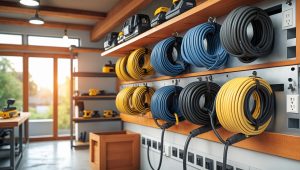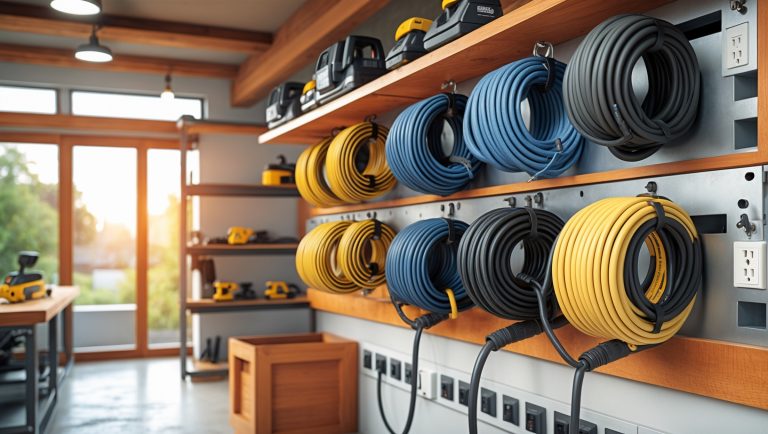Introduction: The Overlooked Power of Surge Protection in Home Workshops
Every home DIYer dreams of a safe, efficient, and organized workshop. But while much attention goes to tool choices, storage solutions, and workbench design, one critical aspect is often underestimated: how you distribute and protect your workshop’s electrical power. A single surge or overloaded power strip can put expensive tools at risk, disrupt your workflow, or in worst cases, cause fire hazards. If you’ve ever wondered whether that aging power strip under your bench is enough, or what the difference really is between a $10 surge protector and a $50 one, this guide is for you.
This in-depth article will walk you through the key differences between surge protectors and power strips, how to choose the right one for your specific needs, and the step-by-step process to safely install and maintain them. We’ll cover practical considerations like amperage ratings, workshop layouts, tool compatibility, and what features matter most for protecting your investment. Whether you’re just setting up your first workspace or upgrading an established garage shop, understanding your electrical protection options is essential for efficient, safe, and worry-free DIY work. Let’s make sure your next project—and every tool you’ve invested in—has the power and protection it deserves.
Understanding the Basics: Power Strips vs. Surge Protectors
What is a Power Strip?
A power strip is a block of electrical sockets that allows multiple devices to connect to a single wall outlet. It’s a convenient solution for expanding limited access to power in workshops, garages, and basements. However, most basic power strips offer no protection against voltage spikes or surges—they simply split the available electricity between devices.
What is a Surge Protector?
A surge protector looks similar to a power strip but includes internal components (often metal oxide varistors or MOVs) that absorb and divert excess voltage during a power surge. This is crucial for protecting sensitive electronics and tools with delicate internal circuitry, such as battery chargers, computerized measurement devices, and smart home gadgets.
- Power Strip: Expands outlets, no surge protection.
- Surge Protector: Expands outlets, absorbs voltage spikes, often includes indicator lights and reset switches.
Key Differences
- Protection: Surge protectors offer voltage spike protection; power strips do not.
- Price: Surge protectors are typically more expensive due to added components.
- Certifications: Surge protectors usually carry UL 1449 certification.
- Use Cases: Power strips are fine for non-sensitive loads (fans, lamps), but surge protectors are essential for power tools, chargers, and electronics.
Why Surge Protection Matters for Home Workshops
The Risks of Power Surges
Power surges can result from lightning strikes, power outages, tripped breakers, or even large appliances cycling on and off. These spikes can instantly damage motors, batteries, microcontrollers, and other components in modern power tools and gadgets. Even minor, repeated surges shorten the lifespan of your equipment.
Cost of Tool Replacement
Modern power tools aren’t cheap. A single fried battery charger or digital measuring device can easily cost $50–$200 to replace. Add in the inconvenience and potential project delays, and the cost of skipping proper surge protection quickly outweighs the modest investment in quality devices.
Workshop Layout and Electrical Load
Workshops often house multiple high-draw tools—table saws, compressors, chargers, and lighting—all sharing limited outlets. Proper surge protection and distribution is essential for both safety and convenience.
How to Choose the Right Surge Protector or Power Strip
1. Assess Your Needs and Power Requirements
- Count Your Tools: List all devices you’ll plug in simultaneously.
- Check Amperage: Calculate the total amperage draw; most residential circuits are 15 amps.
- Identify Sensitive Equipment: Highlight items with electronics (chargers, smart devices, digital tools).
2. Surge Protection Ratings to Look For
- Joules Rating: Indicates how much energy the protector can absorb over its lifetime. For workshops, aim for at least 1,000–2,000 joules.
- Clamping Voltage: The voltage at which the protector diverts excess energy. Lower is better (330–400V is typical for quality products).
- Response Time: Faster is better—look for less than 1 nanosecond.
3. Certifications and Safety Labels
- UL 1449: The gold standard for surge protectors. Never buy unlisted products.
- CSA/ETL/Intertek: Other reputable safety marks.
4. Outlet Arrangement and Spacing
Many power tools have bulky plugs. Look for surge protectors with widely spaced or rotating outlets. Some advanced models include dedicated high-power outlets for large equipment.
5. Cord Length and Mounting Options
- Longer Cords: 6–12 feet is ideal for flexible workshop layouts.
- Mountable Designs: Wall or bench-mounting keeps cords tidy and reduces tripping hazards.
6. Additional Features
- Indicator Lights: Show protection/status at a glance.
- Resettable Circuit Breaker: Cuts power in case of overload.
- USB Ports: Convenient for charging smart tools and gadgets.
- EMI/RFI Filtering: Reduces interference for sensitive electronics.
Comparison of Top Surge Protector and Power Strip Options for Workshops
Best for Heavy-Duty Tools
- Tripp Lite TLP1208TELTV: 2,160 joules, 12 outlets, widely spaced, 8-foot cord, UL 1449 listed, $35–$45.
- APC SurgeArrest P12U2: 4,320 joules, 12 outlets, 2 USB ports, wall/bench mountable, $45–$55.
Best for Compact or Portable Workspaces
- Belkin 6-Outlet Surge Protector: 900 joules, 6 outlets, 4-foot cord, $15–$20.
- Anker PowerExtend Strip: 1,700 joules, 6 outlets, 3 USB, slim profile, $25–$30.
Budget Picks
- Amazon Basics 8-Outlet Surge Protector: 4,500 joules, 8 outlets, 6-foot cord, $20–$25.
Things to Avoid
- Uncertified (no UL/ETL/CSA label) strips.
- Outdated surge protectors (older than 3–5 years, as MOVs degrade over time).
- Low joule ratings (<500) for critical equipment.
Step-by-Step: Safe Installation of Surge Protectors in Your Workshop
1. Plan Your Layout
Sketch your workshop and mark the location of all outlets, benches, and major tools. Decide where surge protectors will be most accessible and least likely to cause clutter or tripping hazards.
2. Inspect Existing Outlets
- Check that wall outlets are not damaged or loose.
- Test for ground faults and ensure outlets are properly grounded.
- Consider upgrading to GFCI outlets for added safety, especially in garages or basements.
3. Mount Surge Protectors Securely
- Use mounting holes or brackets to secure units to the wall or underside of benches.
- Keep surge protectors off the floor to avoid moisture and dust.
- Route cords neatly using cable ties, clips, or raceways.
4. Properly Load Your Surge Protector
- Never daisy-chain power strips or surge protectors.
- Plug in high-draw tools (e.g., compressors, saws) directly to wall outlets if possible.
- Use surge protectors mainly for chargers, small power tools, and electronics.
- Check the total amperage draw does not exceed the device or circuit rating.
5. Test and Monitor Functionality
- Check indicator lights regularly; replace if the protection light goes out.
- Test reset switches and circuit breakers monthly.
- Replace surge protectors every 3–5 years, or after any major surge event.
Maintenance Best Practices for Long-Lasting Protection
Regular Inspections
- Inspect all cords and outlets for fraying, scorching, or loose connections.
- Clean dust and debris from surge protectors and outlets with a dry cloth or compressed air.
Replacement and Upgrades
- Understand that surge protectors wear out—MOVs degrade over time, even without visible damage.
- Upgrade to a new unit if your protector is more than 5 years old or after a major power event.
Proper Use Habits
- Never cover surge protectors with rugs or tools—allow ventilation.
- Unplug surge protectors during extended periods of non-use or when severe storms are forecast.
- Label surge protectors for easy identification in multi-user workshops.
Compliance, Insurance, and Safety Considerations
Electrical Code Basics
- National Electrical Code (NEC) discourages permanent use of extension cords and power strips—install more outlets if needed.
- Never use indoor-only surge protectors in damp or outdoor areas.
Insurance Implications
Some homeowners’ insurance policies may not cover tool damage from surges unless proper protection is in place. Document your surge protector models and installation for peace of mind.
Fire Safety
- Don’t overload circuits—know your breaker’s amperage limit.
- Keep surge protectors away from flammable materials.
- Install smoke detectors in or near your workshop.
Common Myths About Surge Protectors and Power Strips—Debunked
- Myth: “All power strips offer surge protection.”
Truth: Only those labeled and certified as surge protectors do. - Myth: “A surge protector lasts forever.”
Truth: MOVs wear out; replace every 3–5 years or after a major surge. - Myth: “I only need one surge protector for my whole workshop.”
Truth: Multiple units may be necessary for different zones and tool types. - Myth: “Surge protectors prevent all electrical damage.”
Truth: They help, but extreme surges (e.g., direct lightning strikes) may require whole-house protection.
Conclusion: Empowering Your Workshop with Smart Power Choices
When you’re building, repairing, or upgrading anything at home, you want your tools to be reliable, safe, and ready to go. Investing time and a modest budget in the right surge protectors or power strips is a small price to pay for peace of mind and the longevity of your equipment. From understanding technical ratings to planning your layout and maintaining your gear, the steps outlined above will help you avoid common pitfalls that can lead to costly repairs or even dangerous situations.
Remember: not all power strips are created equal. Always opt for certified surge protection for your most valuable and sensitive equipment. Don’t ignore warning signs such as flickering indicator lights or worn cords, and make regular inspection a habit—just as you would with any other critical tool in your shop. With a well-planned power distribution setup, you’ll enjoy a more organized workspace, fewer interruptions, and the confidence that your hard-earned tools are shielded from electrical hazards. Protect your investment, stay safe, and keep your workshop humming—project after project, year after year.










When installing a surge protector in my workshop, is there a best location to place it for maximum protection? For example, should it be closer to the breaker panel, or right at my main workbench where I plug in most of my tools?
For maximum protection of your workshop tools, place the surge protector at your main workbench where you plug in most devices. This ensures your equipment is directly shielded from surges. Installing it near the breaker panel is less effective unless you’re using a whole-home surge protector. Be sure the protector is easily accessible for monitoring and reset.
When you talk about differences between a $10 and a $50 surge protector, is it just about how much voltage they can handle, or are there extra features that make the pricier ones better for running things like saws and sanders? I’m trying to balance protection and budget.
The price difference isn’t just about voltage handling—more expensive surge protectors often provide higher joule ratings (which means better protection), longer warranties, better build quality, and sometimes extra features like multiple outlets, wider spacing for bulky plugs, and indicator lights to show protection status. For tools like saws and sanders, look for a protector rated for higher current (amperage) and with a high joule rating, balancing your needs with your budget.
You mentioned that basic power strips don’t protect against voltage spikes, but is there a way to tell just by looking at a device whether it’s a surge protector or just a power strip? I’m worried I have the wrong type in my garage and don’t want to risk my tools.
You can usually tell the difference by checking for words like ‘surge protector’ or ‘surge protection’ printed on the device or its packaging. Surge protectors often have an indicator light showing protection status, while basic power strips typically lack this feature. If your device only says ‘power strip’ and has no mention of surge protection or a protection light, it’s likely not a surge protector.
Can you explain whether investing in a $50 surge protector actually makes a big difference for heavy-duty tools in a workshop, or if a regular $10 one is usually good enough for most home DIY setups?
For heavy-duty tools in a home workshop, a higher-end surge protector—like a $50 model—offers better protection, higher joule ratings, and may handle larger surges caused by power tools cycling on and off. Cheaper $10 power strips typically have minimal surge protection and may not be rated for heavy loads. If you’re running expensive or sensitive equipment, investing in a quality surge protector is worth it for added safety and tool lifespan.
You mentioned the risks of overloading power strips in a home workshop. If I’m running several tools but not all at once, what’s the best way to figure out the right number and type of surge protectors or strips for my setup without risking a fire hazard?
To avoid overloading, first check the wattage or amp ratings for each tool and add up the total that might be running at the same time. Choose surge protectors or power strips rated for higher loads than your maximum usage. Spread out your tools over several strips if needed, and always plug heavy-duty equipment directly into wall outlets. Never daisy-chain strips, and regularly inspect cords and outlets for wear or heat.
Could you explain how to figure out the right amperage rating for a surge protector or power strip in a workshop where I might be running several devices at once? Is there a formula or rule of thumb I should use to avoid overloading the circuit?
To determine the right amperage rating, first add up the wattage of all devices you’ll be using at once. Divide the total by your workshop’s voltage (typically 120V in the US) to get the amperage. For example, 1500 watts divided by 120V equals 12.5 amps. Choose a surge protector or power strip with a rating equal to or higher than this number, but never exceed your wall outlet or circuit’s limit, usually 15 or 20 amps.
The article explains the difference between $10 and $50 surge protectors, but I’m wondering what features actually justify the higher price. Are there certain certifications, indicator lights, or replaceable components that make the extra cost worthwhile for a home workshop setting?
Higher-priced surge protectors often have features that add value in a home workshop. These can include a higher joule rating for better protection, certifications like UL 1449, indicator lights to show protection and grounding status, and sometimes replaceable surge modules or fuses. Some also offer more outlets, wider spacing for bulky plugs, and built-in circuit breakers. These extras can be worth the cost if you’re protecting valuable or sensitive equipment.
You mention that some surge protectors cost significantly more than others, like $10 versus $50 models. Can you elaborate on what specific features or ratings justify the higher price in a home workshop setting?
Higher-priced surge protectors often offer a higher joule rating, which means they can absorb more energy from power surges, providing better protection for your tools. They may also feature more outlets, individual switch controls, built-in circuit breakers, indicator lights that show protection status, and better build quality. Some premium models include warranties for connected equipment, giving extra peace of mind in a home workshop.
After installing a surge protector in my workshop, what maintenance steps should I take to make sure it stays effective over time? Are there signs that indicate I need to replace it, or is it safe to assume it keeps working as long as power flows through it?
After installing a surge protector, check its indicator light regularly—most have one that shows they’re still providing protection. If the light goes out or changes color, it’s usually a sign the unit no longer protects against surges and needs replacing. Also, replace surge protectors after any major electrical event, like a lightning strike or power surge, even if they appear to work. It’s not safe to assume they’re effective just because power still flows through them.